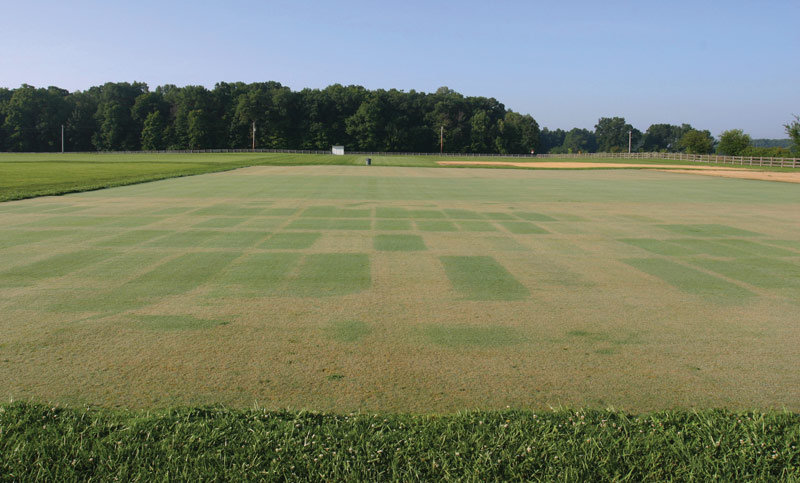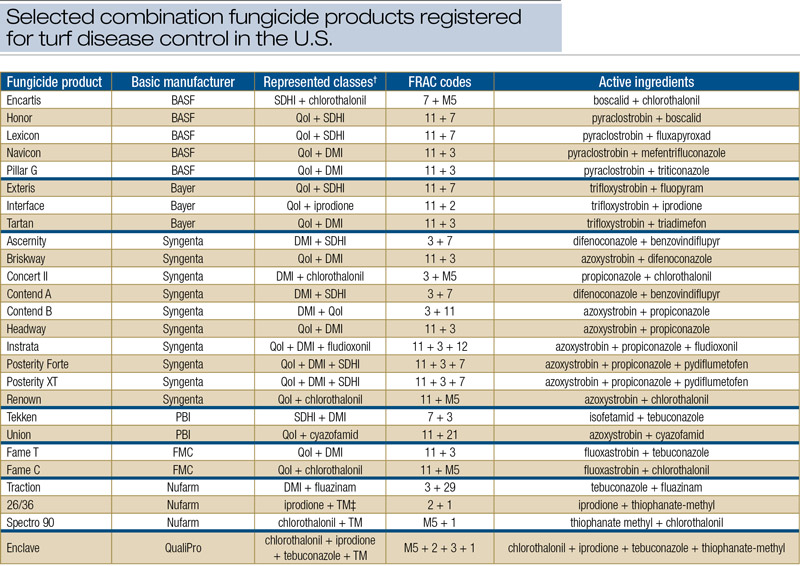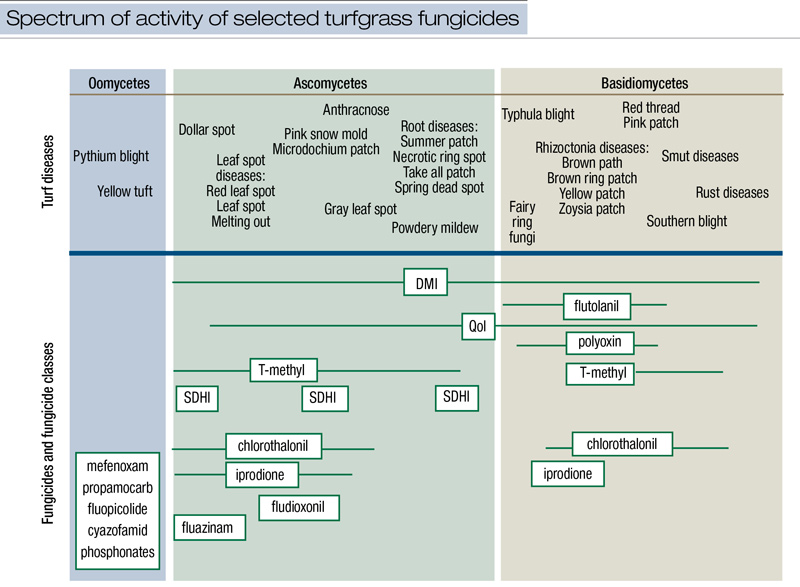
Combination fungicides showed increased efficacy in field plot research conducted at Purdue University’s William H. Daniel Turfgrass Research and Diagnostic Center in West Lafayette, Ind. Photo by Rick Latin
Combination fungicide products — products formulated to include more than a single active ingredient — were rare only a decade ago. Concert (propiconazole + chlorothalonil, Syngenta), Honor (pyraclostrobin + boscalid, BASF) and Instrata (propiconazole + chlorothalonil + fludioxonil, Syngenta) were among the earliest introduced into turf markets. Currently, more than two dozen combination fungicide products are marketed by most of the basic manufacturers (Table 1, below).
Click on image to enlarge:

†Individual fungicides are listed if they are not within major classes (DMI, QoI and SDHI).
‡TM, thiophanate-methyl.
Table 1. Descriptions of selected combination fungicide products registered for turf disease control in the U.S.
Not that the notion of combining fungicides is something new. Superintendents had been tank-mixing different fungicides long before premixed products first hit the market. Chemical companies were smart to recognize how superintendents combined certain fungicides to achieve improved disease control. Additionally, with premixed fungicides, manufacturers offer optimized formulations of two or more active ingredients and the convenience of handling a single product on spray day.
Advantages of combining fungicides for turf disease control
Reaching more pathogens
One of the disease-control advantages of combining fungicides into a single formulation is to broaden the spectrum of activity of the treatment — that is, to reach more target pathogens with a single application. Spectrum of activity for any compound is first defined by manufacturers in laboratory and greenhouse experiments, then verified in field trials, and ultimately tested on commercial sites (golf courses).
When fungicides are registered by the U.S. Environmental Protection Agency, the target diseases are listed on the product labels. Figure 1, below, displays the spectrum of activity of modern fungicides and fungicide classes registered for use on turf.
Click on image to enlarge:

Figure 1. This illustration represents the spectrum of activity of selected turfgrass fungicides. Above the blue line, diseases are arranged in an evolutionary hierarchy from left (diseases caused by most primitive pathogens) to right (diseases caused by most advanced pathogens). Below the blue line, fungicides and fungicide classes are positioned beneath diseases where activity is expected. T-methyl = thiophanate methyl.
Subdue Maxx (mefenoxam, Syngenta), for example, lists efficacy for only three pathogens, whereas Insignia (pyraclostrobin, BASF) is labeled for use against pathogens of 26 turf diseases. Activity of any fungicide varies with application rate and target pathogen. Based on biochemical mode of action, all compounds within a class are expected to show activity against a similar range of fungal pathogens. However, differences in efficacy among active ingredients are often observed within a given class (for example, DMI).
Increasing potency
A second advantage is to increase the potency of the treatment — a benefit that has both direct and indirect influence on disease control. From a direct perspective, two active ingredients are more likely to kill the target pathogen than either individually.
One might question whether the use of two active ingredients with a similar spectrum of activity is overkill and therefore inefficient. The answer lies in our understanding of fungicide depletion from the turf profile and the expected duration of fungicide protection.
Once a fungicide is applied to turf, several physical and biological forces work to remove or degrade the active ingredient. Only a small proportion of the fungicide deposit is removed by surface water and mowing. Most of the fungicide is degraded by a teeming community of microorganisms that naturally inhabit soil, thatch and leaf surfaces. Microbes are quick to attack substances like fungicides and break them down into components useful for their own nutrition and growth. Also, fungicides that penetrate plant surfaces (aka systemics) are not safe from attack. Plants respond to fungicides within their tissues by dispatching enzymes that transform and detoxify alien substances (xenobiotics).
Editor’s note: Your soil is teeming with trillions of organisms. Get to know this subterranean cast, how the various microbes keep grass green and growing, and how you can support them in Soil microorganisms: A turf manager’s guide.
Given the relentless assault on fungicides in the turf environment, it is no surprise that concentrations decline to sublethal levels in short order (in many cases, within seven days) — and here’s where the direct benefit of two active ingredients fits in. Although pathogen cells are not killed by sublethal concentrations of individual fungicides, they are seriously poisoned and are far from healthy. If cells are exposed to two (or more) active ingredients, then, despite declining concentrations of each, the combination is more likely to deliver a death blow — stopping fungal growth, interrupting infection and allowing turf recovery.
The point is, two or more active ingredients will result in a greater reduction in pathogen populations, even when individual fungicide concentrations are no longer lethal by themselves. And reducing populations is the key to lengthening residual activity — the time between fungicide applications and the reappearance of symptoms. Naturally, this threshold from lethal to sublethal concentrations differs among turf pathogens. My guess is that it is quite high for anthracnose and Microdochium pathogens, because achieving control with a single active ingredient is inconsistent, even under conditions of moderate disease pressure. Root disease control is also improved with fungicide combinations, perhaps because pathogens hide in the turf profile where fungicides are more prone to microbial breakdown, confounding attempts to deliver lethal concentrations below turf surfaces.
Indirect benefits of combining fungicides for turf disease control
Indirect benefits of increasing the potency of the treatment involve fungicide resistance management. The rise of resistance is driven by two factors — selection pressure and mutation. Combining fungicides can limit exposure to each active ingredient (it depends on separation of active ingredients in space and time), thereby reducing selection pressure for pathogen strains with resistance to each individual fungicide.
We also know that fungicide rotation (avoiding fungicides with the same FRAC codes in successive applications) reduces selection pressure for resistant strains. Considering the substantial arsenal of fungicides registered for use against diseases where resistance risk is high (for example, anthracnose, dollar spot and Microdochium blight), the use of combination products within an effective rotation offers a doable resistance management tactic.
Furthermore, the increased efficacy — even with declining fungicide concentrations — can reduce the risk of mutation toward resistance. Although it has long been overlooked, ample evidence exists that fungal cells mutate under stress. Sublethal concentrations constitute a level of stress that will prompt all kinds of mutations, including those to fungicide insensitivity. If combining fungicides increases fatality among cells exposed to sublethal concentrations, then mutation frequency will be reduced.
Conclusion
So here’s the bottom line. Fungicide manufacturers register combination fungicides to optimize the formulation of two or more active ingredients. The combined fungicides broaden the spectrum of activity and increase the potency of each treatment. Increased potency further reduces pathogen populations, leading to a longer duration of control. It also reduces the risk of resistance to individual fungicides or fungicide classes and can lessen stress-induced mutation among survivors.
Note: Applying fungicides (premix or tank mix) at sublethal concentrations from the outset, as was once proposed in 2002, is not recommended. The likely effect would be higher pathogen populations, more disease and increased resistance risk. As referenced here, the sublethal concentrations occur during the degradation process, after the “lethal” concentrations have killed cells and driven populations downward.
The research says ...
- Combination fungicide products provide optimized formulations of two or more active ingredients and the convenience of one product.
- Combination products reach more pathogens with a single application and will result in a greater reduction in pathogen populations.
- Combining fungicides can limit exposure to each active ingredient, reducing selection for pathogen strains with resistance to each individual fungicide.
Selected references
- Couch, H.B. 2002. Better dollar spot control with less fungicide. Golf Course Management 70(11):89-93.
- Daniels, J., and R. Latin. 2013. Residual efficacy of fungicides for controlling brown patch on creeping bentgrass fairways. Plant Disease 97:1620-1625 (https://doi.org/10.1094/PDIS-12-12-1130-RE).
- Gressel, J. 2011. Low pesticide rates may hasten the evolution of resistance by increasing mutation frequencies. Pest Management Science 67:253-257 (https://doi.org/10.1002/ps.2071).
- Latin, R. 2021. A practical guide to turfgrass fungicides. APS Press, St. Paul, Minn. (in press).
Rick Latin is professor emeritus of plant pathology at Purdue University, West Lafayette, Ind., and the recipient of GCSAA’s 2018 Col. John Morley Distinguished Service Award.